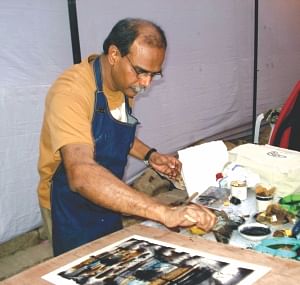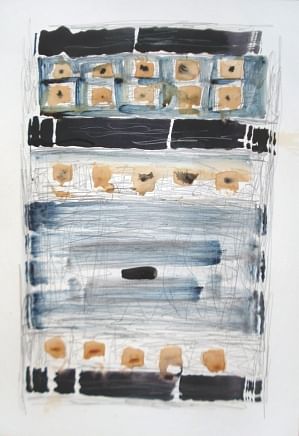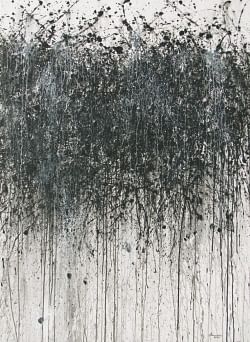| Home - Back Issues - The Team - Contact Us |
 |
| Volume 10 |Issue 33 | August 26, 2011 | |
|
|
Art Lyrical Dreams with Lines and Dots Fayza Haq
Syed Hasan Mahmud, is a contemporary of well loved teachers of the Dhaka Art College, like Nisar Hussain and Shishir Bhattacharya and Wakilul Rahman (who is basically based in Germany). He was speaking on a rain drenched afternoon, in Dhanmandi, in his school for adults and children called “Jhanpai” on behalf of himself and his wife, Atiya Islam Anne, says “It is very important that a painting does not become a design. Whether we create a realistic piece of work or abstract one, the matter of the space is very important. There are so many dialogues in so many artists' work. When doing abstraction, there is more chance of this happening. The painting should pulsate with the rhythm of life. Since abstract painters don't create vivid with their forms. He must use the pigment, space and language, as well as colour bindings in a manner that they aim at aesthetic values.” Hasan's works are a combination of dots and lines, done carefully, each large painting taking a fortnight to three months. Each stoke is applied individually, with a fine brush. No spray is applied, as is done so often in the works of other contemporary artists. The use of collage in his works adds depth and other dimensions to his work. The rectangle pieces, added on, are in earthy colours of pale mauve, russet, bunt; pink leafy bottle green, and such muted hues. There is nothing garish or loud in his works. The black and white dots and dashes, – which bring in nature around us—and the gentle range of collage work represent, also life's experience, of life, which is fragmented and which combines experiences of the past and present with hopes and dreams of the future.
He takes pride in telling you that it is abstract art and that he has been greatly influenced by Mohammed Kibria, who encouraged and inspired him. The European painter Mondrian also influenced his work. Hasan has tried his hand at various mediums. This includes pastel, water-colour, oil colour, wash and ink, collage this includes he work from 1982 to 1998. From 2000 on to 2011 his has worked in acrylic and mixed media. He has brought in nature, personal feelings in his choice of colours and forms, which remain subtle and subdued. “No artist, in my view, can say that he is not influenced by one or another artist of the past. No painter can say that he is totally original. So many types of paintings have come into existence that to create something new is an enormous task," says Mahmud. “Taking famous cave paintings in France in focus, the painters did not do them for leisure. To pinpoint the place at which the arrow, or spears should be aimed, the paintings were made. The human figures, meanwhile, were like matchstick men, complete with just lines and circles. There were no details in them. The belief was that if humans were painted, they too would get captured. These cave paintings remain like masterpieces in our mind.” The artist cum teacher continues to say that the language of painting has changed. Installations have been introduced, some years back. Our contact with the world outside is direct, and not from brochures, magazines, newspapers or books. It's a great pleasure for us to the good visual art work from abroad. Even if the number of entrees is reduced, if the display of good paintings continues, says Hasan, the standard should be maintained. Speaking of the source of inspiration for his work, Hasan says, Shilpacharaya Zainul Abedin and his pen sketches of the early 40's famine–which he saw in newspapers, like “The Bangladesh Observer”, and the works of Safiuddin Ahmed and Qamrul Hasan – the three giants of Bangladeshi art had indelible marks on his mind. Hasan adds that he likes the works of SM Sultan too. At the same time, says Hasan, when the Liberation War began in 1971 his school closed, and he read newspapers of that time, he came across the bold lines of Zainul Abedin's “Monpura” which focuses on the awful Bengal Famine of 1942-1943. The bold black lines that brought in the moving images of the crow pecking at the food in open containers of metal plates, the pot-bellied hungry children on the street, the poor, helpless, bedraggles mothers—the unparalleled hunger, need, and poverty moved him intensely, as every sensitive reader. The bold lines, the brought in 3D images to the mind, says Hasan were nonpareil and unforgettable. Qamrul Hassan's water-colours that brought in scenes of the villages, with the rivers, shy women carrying water-vessels and little babies on their hips, timid wives, with their mouths covered, with the ends of their “saris”, which he came across in his family home at Dhanmandi, Dhaka, moved him no end. He felt, right from the outset, when he joined the Dhaka Art College that he wanted to make abstract paintings.
At first, says Hasan, he began copying pictures. He saw the great Bangladeshi artists, like SM Sultan, Zainul Abedin and other giants. He also saw European masters in the art books in the college library. Painters of the Renaissance period like Leonardo da Vinci and Michel Angelo along with modern masters such as Pablo Picasso, Braque, Moore and Bacon, in a book that Hasan possessed – had their impact on him — as on all art books did on students of his time and others before him and after. After copying these, he came across the works of Paul Klee, Piet Mondrian, Kandinsky. Hasan says he couldn't, since then, be quite be satisfied with realism and what realistic vision had to offer the world. That he says was his love with abstraction—a love which hasn't died in him. His penchant and passion for that genre still fascinates him, and he feels will always be within him – to stir him on. Yes, he went through the rigours of the academic training of realistic drawing and painting, based on models and painting from river scenes and railway station settings. He enjoyed the lines and dots of abstract work and made drawings and paintings at home on those lines and kept them, to show them in time to connoisseurs like Mohammed Kibria himself -- the great living artist at that time. He taught at the Dhaka Art College, and was at hand to see Hasan's works, to encourage and egg him on. They included layer upon layers of colours, blending together, and some peeping from beyond; and bringing in the ambiance of the time and space around him. They were a combination of various experiences at different times of life around—in abstract form instead of bringing in anything figurative. The pictures blended the past with the present, mixing and mingling hopes and reminiscences. “One has to try at various things. Forms are there. The different surfaces and pigments have to be treated in various ways in order to delight the viewer, and make his mind run on. This is not easy or something that can be done quickly. The labour of love takes time and patience. Each leaf, stem, vine etc is layered on carefully and minutely. Each detail is worked upon methodically. Nothing is hurried,' says Hasan.
Copyright
(R) thedailystar.net 2011 |


